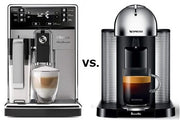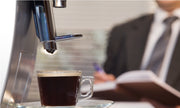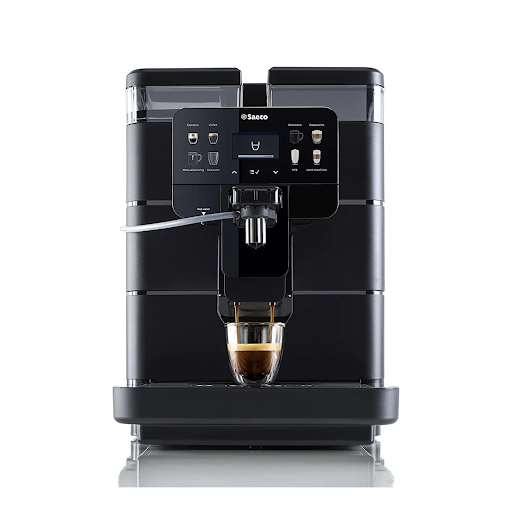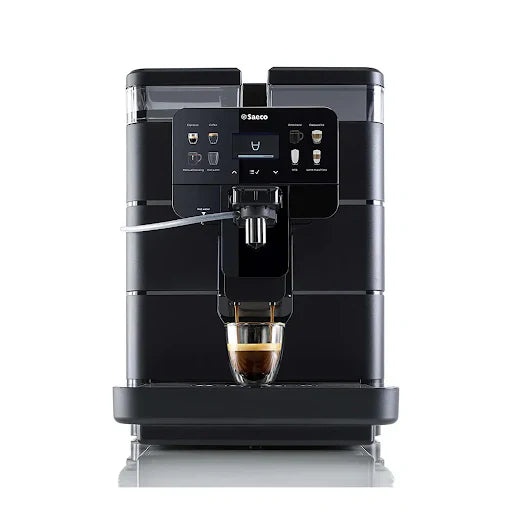The origin of the Espresso and Espresso Machine

For many coffee drinkers, the espresso is coffee. In many countries, ordering “a coffee” is equivalent to ordering an espresso. Italy included, the land where the espresso and the espresso machine were born.
The espresso, and its variants, may be the most popular form of brewing coffee but it’s not the oldest. On the contrary, it’s relatively recent, dating back to the 19th century only. Coffee is as old as a millennium instead and being drunk all over the Europe and Americas since at least 4 centuries. A much different kind of coffee, as it didn’t possess the famed “crema” nor the quality of beans was so important as it is today. But it was still one of the most popular beverages, with a worldwide spread.

Our Signature Caffe' Nostro Espresso Beans
But espresso didn’t get introduced until a breakthrough in technology, the steam machine, got applied to the world of coffee brewing. Until that, coffee was brewed mostly like tea is still nowadays: heating water and mixing it somehow with ground coffee. Many still brew it like this to this day, and with excellent results.
It was only until the introduction of steam to the formula that espresso, and the first espresso machine, was born. Pressured water is inseparable from espresso. Without it, it is simply coffee, good, excellent coffee but not espresso.
The principle behind espresso
Without going into technicalities, the basic concept in brewing coffee, whatever the method you use, is simple: apply water, hot or cold, to ground coffee. Keep it enough time to let the extraction of the flavours from the coffee get into the water. Drink.
The first man behind espresso, Angelo Moriondo of Turin, Italy, added a new principle: why not inserting pressure, under the form of a jet of hot water, to make coffee? Would that work?
As anybody who has ever drank a coffee from an espresso machine, yes, it does work indeed. That was in 1884 and the first, albeit quite bulky and more like a prototype, espresso machine was born.

Already back then, the principle in creating an espresso was present and the formula not very dissimilar from today’s evolved super automatic espresso machines: a jet of hot water (88°-93°C/190°-200°F), with a 9+ atmospheres of pressure, passes through a seven-gram (.25 oz) layer of ground coffee. Done right, the result is a concentrate of not more than 30 ml (one oz) of coffee.
Moriondo failed to market his invention. It worked but remained in the world of prototypes that generated vague interest from investors. The idea behind it was not a failure though. The formula of hot water + pressure + a medium quantity of ground coffee, caught.
The first espresso machines
Back in the 19th century, cafes were popular all over the Western world and not only. Mostly consumers were enjoying coffee seated, sipping it from time to time, without hurrying. It was a social moment, to spend the time with friends and acquaintances while drinking something that would keep you alert. Not very differently than today.
The problem that the first espresso machines tried to solve was of scale. Brewing coffee took some time, a few minutes per cup, and customers were aplenty. Being able to serve them quickly was getting more important as the world became progressively more frantic. Industries, workers commuting, newspapers were all social changes that were happening right before the invention of espresso and spurred its creation.
Another Italian, Luigi Bezzera, thought that the first machine of Moriondo could be improved and made to serve lots of coffee, short and strong, very quickly. In the early years of the 20th century he invented the single-shot espresso machine, introducing many improvements that are still in use today: the portafilter, multiple brew heads and a large boiler to have a large reserve of hot water to brew. The water was heated by a real fire, making it cumbersome and impractical to use, but worked.
This rudimentary espresso machine was patented in 1903. It was not Bezzera though that made the new machine popular. He was more a technician, not a marketer. One of his friends did, Desiderio Pavoni. He bought the patent and improved it by adding the steam wand (another feature still in use in today’s super automatic and manual espresso machines), a pressure valve, allowing to control more precisely when and how much hot water to pour, and presented it at the Milan Fair of 1906. He branded the new machine “a machine for cafeé espresso” and the name stuck. The machine was a success, being able to brew up to 1000 cups of coffee each hour, something unthinkable before.
The Pavoni “Ideal” machine, so it was named, dominated the first decade of the espresso world but was mostly an Italian market success. Appreciated locally but unknown elsewhere. A big name was going to change this soon.

Commercial successes
Achille Gaggia, a café owner in Milan, perfected Pavoni’s espresso machine, introducing the lever to make the pressured water go through the coffee, and increasing the pressure to 8-10 bars. That was after World War II.
The lever and chrome-coated machine became iconic, and the term “pulling a shot” became synonymous with making an espresso. Gaggia’s machine was the first to have a proper crema, thanks to the increased pressure. That changed the appeal of the drink and made espresso truly a separate breed of coffee drink.
From there, the espresso machine, still manual, became a staple of cafes everywhere. Novelty, good marketing and a world that traveled at increasingly higher speed were key to the fascination with this quick, strong and creamy version of coffee. Most people wanted to enjoy a good coffee but hadn’t the time as before to sit for half an hour to properly drink a long black coffee drink. The espresso was perfect for the new society, pulling a coffee in mere seconds and drinking it in 3-4 short sips.
Throughout Europe, the espresso became the most commercially successful drink for those liking to have a coffee outside. Cafes installed various versions of the espresso machine, to accommodate customers’ requests. During the 50s and 60s, the espresso way of drinking coffee was more connected with Italians exporting the drink and local communities of immigrants. It took a while for it to become popular outside of the cafes frequented by Italians. But it eventually did.
In the 60s the espresso machines became popular in California, mostly to make versions of cappuccinos and lattes. From there, the machine became important throughout the West Coast, ending up fueling the birth of the North-western coffee culture. The rest is history, as they say.
The evolution of the Espresso Machine
In the first decades, the machines were manual. The espressos were made by physically pulling the lever to allow the pressurized water through the ground coffee. Later the water would become steam, thanks to the invention of Francesco Illy in 1933, but the operational method remained similar.
It was Faema, another company from Milan, that in 1961 introduced the first semi-automatic espresso machine. It was operated by a pump-driven motor and accepted water directly from a cold source, being able to heat it quickly on its own. It became massively successful as it required little time out of the baristas to brew the espresso and was much smaller in size, allowing smaller businesses to install one in narrow spaces too.

This development allowed companies to produce small espresso machines that didn’t need any training to be operated and could then be sold as home supplies. Which they did.
A proliferation of different brands and models started to cater to the home consuming, to normal people who wanted to enjoy a good espresso cup in the comfort of their homes. DeLonghi, Saeco, La Marzocco, Jura, Philips all started producing excellent espresso machines, and are doing it to this day.
These machines were all semi-automatic, automatic or super-automatic. The difference between the categories being in how much the brewing process is automated. Semi-automatic machines are more similar to the ones used in cafes at the beginning of the espresso-mania. They require the barista to calculate the brewing time and separately grind the coffee, other than putting the ground coffee in the portafilter. More control over the final drink, but more work.
Automatic espresso machines became more successful for home sales thanks to requiring no calculation of the brewing times, being pre-set in the machine already. Grinding and tamping the ground coffee was still required but an easy process.
Super-automatic espresso machines are the most evolved type. They require little to no intervention from the user to operate, having automatized the whole grinding, tamping and brewing chain. Nowadays most are operated via a touch screen or an app, for an even friendlier experience. Models like DeLonghi Magnifica, La Spaziale Vivaldi are the modern expressions of the most super-automatic machines. Others like the Saeco Aulika integrate even milk-based drinks in it, automating the whole process of milk and coffee brewing at the pressing of a button.



Click below to
Explore the Superautomatic Espresso Machines
These days models are increasingly going toward simplicity, effectiveness and elegance. A machine like the Jura A1 is sleek, portable and extremely automatic. The market has gone a long way from the days of huge, room-sized machines that needed multiple operators to produce an espresso after much work. An espresso machine has become a cheap way to prepare excellent coffee at home, with easy steps and not requiring any previous knowledge to be able to enjoy a quality cup of coffee. An espresso machine is accessible to anybody, making espresso a way of drinking coffee possible for everybody.
Click below for Direct Access Links
Stove Top
Coffee Scented Candles
Flavoring Syrups & Sauces
Espresso Machine Experts







